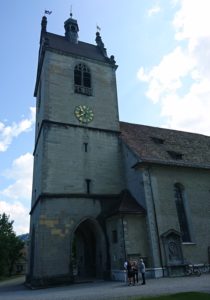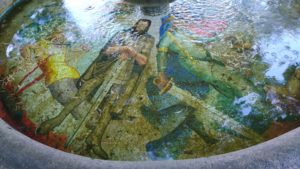Wir starten die heutige Etappe bei der St. Gallus-Kirche.
Sehens- & Wissenswertes
Nach einem knappen Kilometer treffen wir am Fuss des Gebhardsberges (auf dem Berg gut besuchte Wallfahrtskapelle) auf die Kolumbanskirche, errichtet zwischen 1962 und 1966. Nach weiteren 300m erreichen wir das Ufer der Bregenzer Ach. Wir überqueren diesen Fluss, wandern westwärts und bestaunen die Sandplatten mitten im Fluss (Relikte einer vor 20 Mio Jahren versteinerten Meeresküste). Bei der Eisenbahnbrücke verlassen wir die Bregenzer Ach, wenden uns südwärts und folgen etwas mehr als 1km der Eisenbahnlinie.
Beim Verlassen des Stadtgebiets von Bregenz gibt uns der Wanderwegweiser die Richtung an: nach Lauterach. Der Wanderweg, gelb-weiss markiert, führt uns etwa einen halben Kilometer entlang der Bahnlinie bis diese eine Rechtskurve macht. Der Bahnlinie folgen wir während rund 500m bis wir auf eine Unterführung treffen. Wir unterqueren die Eisenbahngeleise und folgen nun dem Wegweiser Jannersee. Dieser liegt mitten im Lauteracher Riet und bietet eine einfache Rastgelegenheit. Wir bleiben auf diesem Weg und erreichen nach weiteren 2.5km das Ufer der Dornbirner Ach. Nach links und etwas über einen Kilometer weiter gelangen wir an die hölzerne Senderbrücke, die wir überqueren (Achtung, Autoverkehr!) und gleich wieder nach links abbiegen. Der nun mäandernden Ache folgend wandern wir Richtung Dornbirn, unterqueren die Autobahn und bleiben weiter am Ufer der Dornbirner Ach.
Wer die Stadt besuchen möchte, verlässt nach ca. 3.5km die Ach und wendet sich dem Stadtzentrum zu. Wer direkt weitergeht, folgt der Ache.
| Km 15 | Dornbirn. Die frühesten Beweise für menschliche Anwesenheit auf heutigem Dornbirner Gemeindegebiet lassen sich in die mittlere Steinzeit (8000 bis 3000 v. Chr.) datieren. Hinweise auf eine römische Anwesenheit im Dornbirner Stadtgebiet liefern Münzen des 2. Jh und eine Fibel aus dem 1. Jh. Den ersten Hinweis auf eine Siedlung auf dem Gebiet des heutigen Dornbirn liefert ein alemannisches Skelettgrab aus dem 6. und 7. Jh.
In einem Vermerk einer 895 ausgestellten St. Gallischen Urkunde wird Dornbirn erwähnt. Dem Kloster St. Gallen gehörte demnach auch in den darauf folgenden Jahrzehnten dieses Gebiet Wie im ganzen Rheintal war und ist auch heute noch die Textilindustrie ein wichtiger Wirtschaftszweig. Zahlreiche Kapellen deuten auf die grosse Frömmigkeit der Bevölkerung hin. Von Dornbirn führt eine Luftseilbahn auf den Karren, einen schönen Aussichtsort. Von dort kann ein Abstieg in die eindrückliche Rappenlochschlucht unternommen werden. Diese kann auch vom Stadtzentrum her direkt erreicht werden. Am Fusse des Berges entlang wandern wir weiter bis |
| Km 24 | Hohenems. In der Stadt befindet sich der Palast Hohenems, das ehemalige Residenzschloss der Grafen von Hohenems. Im 18. Jh wurden in der Schlossbibliothek zwei der drei bedeutendsten Handschriften des Nibelungenliedes gefunden. Hohenems war vom 17. bis zum 19. Jh Wohnsitz zahlreicher jüdischer Familien. Im 20. Jh wurde Hohenems durch das nach wie vor jährlich stattfindende Musikfestival „Schubertiade“ weltbekannt.
|
Von Hohenems bis Chur bestehen zwei Weg-Varianten:
Etappen 14a Hohenems – Feldkirch, 15a Feldkirch – Balzers und 16a Balzers – Chur
Etappen 14b Hohenems – Haag, 15b Haag – Sargans und 16b Sargans – Chur
Mit der Variante über Haag und Sargans bietet sich die Möglichkeit, einen Ort zu besuchen, der in der Vita von Gallus eine wichtige Rolle gespielt hat: Grabs. An diesen Ort flüchtete Gallus über die Saxerlücke, um allfälligen Repressalien des Herzogs aus dem Weg zu gehen. In Grabs entschied er sich zudem, nicht Kolumban nach Bobbio zu folgen sondern sich ins Steinachtobel zurückzuziehen. Ein Brunnen in Grabs sowie das Galluszentrum mit Kolumbanswegplakette erinnern an die Anwesenheit von Gallus in diesem Ort.





















